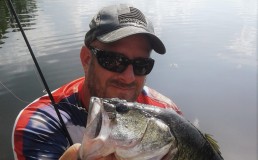Seeing What Your Not Looking For
As April grows small in the rearview mirror and we head into May, many people stop sight-fishing. They figure the spawn has wound down and, in many cases, they’re right but ‘sight-fishing’ need not be confused with ‘bed-fishing’. There’s still a lot to see . . . and catch.
My son and I stood on the dock at our lake and talked over the bass that came and went, including a true giant that busted Hunter’s fluorocarbon line. He had seen the fish eat his bait as it swam in 8 feet of water and that proved too much for the 15-year-old and his 15-pound line. He set the hook like a gorilla.
He then collapsed on the dock like somebody had kicked his gonads through his rib cage.
His girlfriend, Romi, giggled and asked what was wrong with him. It was one of many questions she asked. Among them was, ‘how can y’all see all those fish? I don’t see anything.’
My wife explained about polarized glasses. Even with our Costas though, I explained that there are tricks to seeing fish. And there’s an art to catching them.
Somebody had to teach me so I’m passing along some of the best tips I ever got on the subject of sight-fishing for bass year-round, not just when they’re on the beds.
My teachers include Shaw Grigsby, Bernie Schultz and no less a sight-casting pioneer than Guido Hibdon himself.
The best thing I ever picked up from Hibdon – and passed along to Romi the other day – was to look for ‘game trails’ under the water. “When bass swim, they brush away bottom debris and leave a light-colored trail along the bottom,” shared Hibdon who learned the craft on the deep highland lakes of the Ozarks region. He further expounded that knowing where to look in the first place is half the battle when visually searching for fish.
Hibdon said, “They will swim back and forth along that same trail and if you wait, just like deer hunting, one will come back through the area and you can cast out ahead of him far enough to let the lure settle to bottom before he gets there.”
Letting the lure settle before the fish gets there can be key.
Letting the line sink is critical.
“You never want your line to go over the fish’s back,” emphasized Grigsby after a mid-summer day of sight-casting on Tennessee’s Lake Cherokee. “And you don’t want to cast right at the fish either. If you see one sitting there looking at you, that’s not good. You want to bring the lure at an angle and make it act as if it’s trying to escape. Make the fish think it’s his idea.”
For these reasons, you need to lead the fish by a wide margin when casting to them. This is also a strong reason to use fluorocarbon line as it will sink much faster than mono or braid which means you’ll be less likely to ‘line’ the fish (cast or pull the line over its back).
Bernie Schultz once told me about a tournament on Georgia’s West Point Lake where he saw bass swimming around a shallow point, back and forth at a consistent depth, following game trails as Hibdon had told me they would. “I just tossed a Senko way out in front, made sure it got down, pulled the line beneath the surface and let the fish find the lure.”
It can be just that simple. Not all fish will bite. But Grigsby and Hibdon both estimated their odds of catching any given bass at better than 50%. Their tournament records back that up.
Odds go way up when you see the fish before the fish see you. Keep a low profile, move silently – which means move slowly in most cases. And wear the best quality polarized sunglasses you afford.
Costa del Mar has set the standard for decades. The clearest lenses on the planet not only show you fish, but also protect your eyes from the sun’s harmful effects as well as the occasional flying tungsten sinker. My favorite model, the Blackfin has wide sides to block distracting peripheral glare.
Keep the sun over your shoulder to further minimize glare and then, as Grigsby says, “Put the trolling motor down and go learn what to look for.”
One clue I look for is shadows. Fish are notorious for camouflaging themselves into their environment. But they can’t change the density of their body. They cast consistent shadows when in shallow water. The dark oval on the lake floor is often the first cue I get that there is something swimming, suspended slightly higher in the water column.
When looking for the fish itself, try to first find the vertical black stripe on their tail. This stripe contrasts sharply with the rest of the tail fin and it is nearly always moving – and movement always gives an animal away when it is trying to hide.
Wakes can give fish away. On cloudy days, bulging v’s that ripple the surface may be your most obvious sign. Remember, the deeper a fish swims, the further behind its wake will trail. Also, the deeper the fish swims, the further ahead of it you need to cast. Again, you must get your line down so as not to spook the fish.
Take these tips and go see some fish!

























